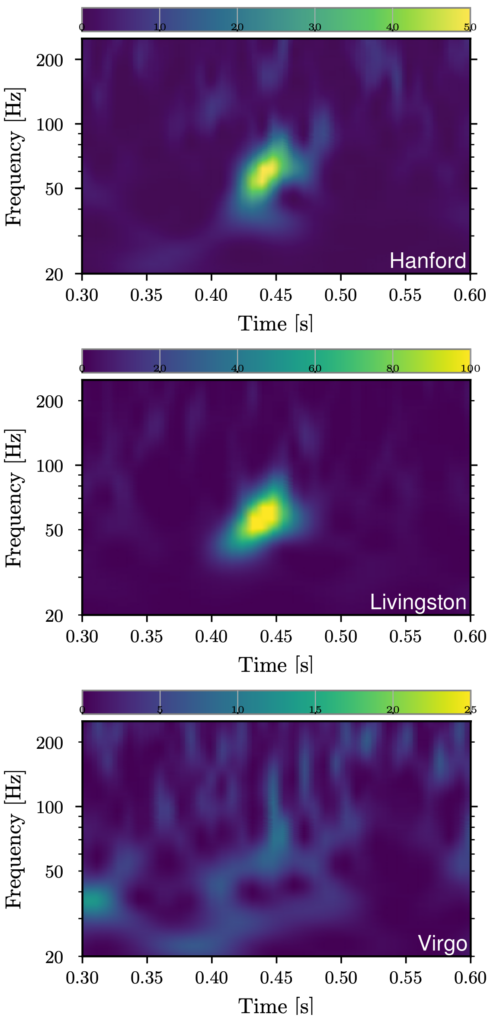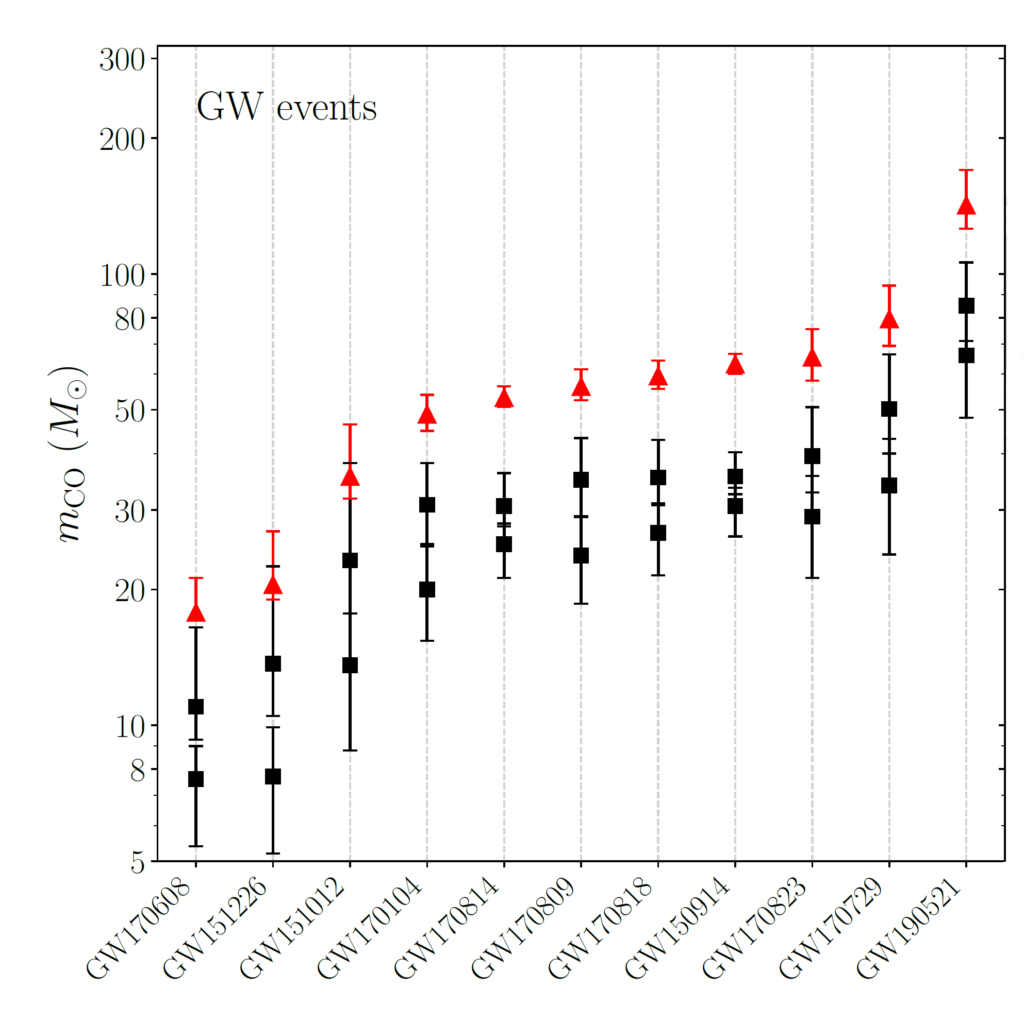What did we observe?
On May 21, 2019, the Advanced LIGO and Advanced Virgo detectors observed a gravitational-wave signal from the merger of an extraordinary pair of black holes. The signal, named GW190521, was shorter in duration, and peaked at lower frequency, than any other binary black hole merger observed to date.
The time interval that the signal from a binary black hole merger spends in the sensitivity band of Advanced Virgo and Advanced LIGO is inversely proportional to the total mass of the binary system. In the case of GW190521 this time interval was only about 0.1 seconds, much shorter than for e.g. GW150914 — the first ever binary black hole merger detected. Similarly, the frequency at which a binary black hole merger signal reaches its maximum is also inversely proportional to the binary’s total mass. For GW190521 this peak frequency was only about 60 Hz, again much lower than for GW150914, where the peak frequency was about 150 Hz. So it was clear from the beginning (see Fig. 1) that LIGO and Virgo had a very big pair of black holes on their hands.

Figure 1: Time—frequency representations of data containing the GW190521 signal, observed by LIGO Hanford (top), LIGO Livingston (middle), and Virgo (bottom). Times are shown relative to 03:02:29 UTC on May 21, 2019. The energy in a certain time-frequency bin is represented by the color palette. Note the signal’s extremely short duration and its peak frequency of about 60 Hz. Click on the image for a higher-resolution version. (Adapted from Fig. 1 of our GW190521 discovery paper.)
Figure 2 shows the measured masses of the black holes that produced GW190521. The larger of these two black holes was around 85 times the mass of the Sun (denoted by the symbol M☉) while the smaller black hole registered closer to 66 M☉. Both of these objects are much more massive than any of the merging black holes detected by Virgo and LIGO so far — and even the smaller black hole is already more massive than many of the remnant black holes formed in those merger events (see Figure 3).

Figure 2: Measured masses of the colliding black holes that produced the gravitational wave signal GW190521 shown as probability distributions. According to the LIGO-Virgo analysis, the true values of the black hole masses have a 90% probability of being located inside the solid blue contour in the central plot (which shows the joint probability for both masses). The same is true for the solid vertical and horizontal lines in the bell-shaped curves to the top and right of the figure, which show the mass measurements for the individual black holes. The grayed-out region of the central plot is due to the LIGO-Virgo convention that the “primary” mass m1 is always of equal or greater value than the “secondary” mass m2. (Taken from Figure 2 of our GW190521 discovery paper.)
For GW190521, the post-merger remnant black hole “weighs in” at around 142 M☉ , putting it well out in front on LIGO-Virgo’s list of biggest black holes. This remnant mass is about 8M☉ less than the combined masses of the two black holes that merged; this mass difference was converted into the energy of the gravitational-wave signal.

Figure 3: Plot showing the component masses (shown as black boxes) of the GW190521 black holes in comparison with the masses of other black hole mergers detected during LIGO and Virgo’s first and second observing runs, O1 and O2. For each event the mass of the merged remnant is shown as a red triangle. In all cases the length of the vertical bar indicates the range of uncertainty in the estimated mass. The record-breaking masses of GW190521 are clear from this plot. (Adapted from Figure 10 of our paper on the astrophysical implications of GW190521.)
Why is GW190521 so interesting?
The extraordinarily large masses of the black holes that produced GW190521 mean more than just bragging rights; they challenge our understanding of black hole formation and serve as a unique laboratory to understand the fundamentals of how gravity works.
Making big black holes
Astronomers classify black holes according to their mass. This is meaningful because black holes at different ends of this mass spectrum form in very different ways. Sitting at the centers of most, if not all, large galaxies are the “supermassive“ black holes with masses from hundreds of thousands to billions of times that of the Sun.
Our own Milky Way galaxy has a black hole at its center that is about 4 million times the Sun’s mass. Exactly how these monster black holes form remains a bit of mystery. However, their formation process likely began when the Universe was much younger, giving the black holes time to grow to such large size.
At the other end of the mass spectrum are the “stellar mass“ black holes, which are thought to be formed from the collapsing cores of high mass stars during supernova explosions. Stellar mass black holes have masses in the range of a few to tens of times the mass of the Sun, and pairs of these objects make up the black hole mergers observed by Virgo and LIGO to date.
Between stellar mass and supermassive black holes is the mysterious realm of “intermediate mass“ black holes, with masses in the range 100 to about 100,000 times that of the Sun. There are no definitive observations of intermediate mass black holes to date, but there are several different scenarios for how they might form. The hunt for intermediate mass black holes has recently picked up in earnest, however, as observing capabilities among telescopes and gravitational wave detectors have improved.
Based on our theoretical understanding of the internal workings of massive stars, and how black holes form, it is thought that black holes with masses between about 65 and 120 times the mass of the Sun cannot be formed by a collapsing star. So GW190521 crashes the party because the mass of larger black hole that merged (the ‘primary’ black hole) sits squarely in the interval where stellar collapse is not expected to directly produce black holes — and, moreover, it produced a post-merger remnant black hole that can be classified as an intermediate mass black hole.
LIGO-Virgo’s observation of GW190521 suggests that either stars can form high mass black holes, or that some LIGO-Virgo black holes form by other means — perhaps as a result of a previous merger between pairs of smaller black holes, which then opens a route to form an even larger black hole by undergoing another black holemerger. This multiple merger scenario requires that black holes form in special environments where there are enough other black holes nearby for multiple merger events to occur. Astronomers have proposed dense clusters of stars or the disks of active galactic nuclei as possible examples of such special environments.
The observation of GW190521 also suggests that the intermediate mass black hole realm may be populated in part by remnants of stellar mass black hole mergers. Similarly, supermassive black holes may also form in this way.
Testing our understanding of gravity
Our theoretical understanding of how gravity works is well described by Einstein’s General Theory of Relativity, or “GR”. Physicists use GR to predict the gravitational-wave signals from merging black holes. In turn, those predictions are used to help analyze the Virgo and LIGO data. On the flip side, the observations of gravitational-wave signals can be used to test the predictions made by the theory itself, and to look for signs of any deviations from GR that might point towards alternative theories of gravity.
Using gravitational waves as physics laboratories is nothing new: previous LIGO-Virgo black hole merger observations have been used to test our understanding of GR. So what makes GW190521 different?
The gravitational wave signal from the collision of two black holes goes through three different regimes (see Figure 4): first there is the “inspiral”, when the two black holes are well separated and orbiting around one another; next there is the “merger“, when the two black holes are joining together; finally there is the “ringdown“, when the remnant black hole “rings“ like a struck bell before it settles down into a stable, final state.

Figure 4: Cartoon representing the three different regimes of the gravitational-wave signal from the collision of two black holes.
As noted earlier, black hole signals are observable in the LIGO-Virgo data for different lengths of time, and they peak at different frequencies, depending on the masses of the black holes. As a result, the detectors are sensitive to different parts of the gravitational wave signal, depending on the mass of the binary. Signals from lower mass black holes are more clearly observed during their inspiral and merger phases. On the other hand, the much higher masses of the black holes which produced GW190521 provide us with the best opportunity yet to study the late merger and ringdown phase of the gravitational wave signal.
Just like with all other black hole signals observed thus far, GR passed the tests presented by GW190521. One such test was to analyze the ringdown portion of the signal separately from the inspiral and merger parts and to check whether or not they were consistent with one another. Tests were also performed to search for extra features in the signal predicted to exist by some alternative theories of gravity, and to test other hypotheses (i.e. as opposed to the merger of two black holes) for the source of the signal itself. None of these tests was able to contradict the interpretation that GW190521 came from the merger of two black holes abiding by the physics described in GR.

Figure 5: This graphic shows the masses of black holes detected through electromagnetic observations (purple), black holes measured by gravitational-wave observations (blue), neutron stars measured with electromagnetic observations (yellow), and neutron stars detected through gravitational waves (orange). GW190521 is highlighted in the middle of the graphic as the merger of two black holes that produced a remnant that is the most massive black hole observed yet in gravitational waves. Click on the image for a larger version. [Credit: LIGO-Virgo/Northwestern U./Frank Elavsky & Aaron Geller]
Summary
GW190521 is a record-breaking gravitational wave observation that pushes the boundaries of our knowledge about how black holes form, and provides a new way to study gravity at its most extreme. It also suggests the existence of a population of high-mass black hole mergers that may be discovered during future observing campaigns with LIGO (including LIGO India), Virgo and KAGRA in Japan.
Surveying the high end of the stellar-mass black hole population will help us to build a clearer picture of the processes that produce black holes, and the environments in which they reside. GW190521 can enjoy its perch as the largest black hole pair observed so far, but should not get too comfortable. LIGO, Virgo and KAGRA will keep searching the skies for gravitational waves with further improved sensitivity, and future detectors will be much more powerful especially at low frequencies where many more heavy black holes should be hiding. New detectors already planned include the Einstein Telescope and Cosmic Explorer down on Earth, and LISA up in space. Records are made to be broken!
Find out more:
- Visit our websites: ligo.org, www.virgo-gw.eu
- Read the LIGO and Virgo press releases about the discovery of GW190521:
- Have a look at the infographic and fact sheet for GW190521.
- Read the freely available full scientific article describing the discovery of GW190521: https://dcc.ligo.org/P2000020/public
- Read the companion scientific article describing the astrophysical implications of GW190521: https://dcc.ligo.org/P2000021/public
- Gravitational-Wave Open Science Centre data release for GW190521: available here.

